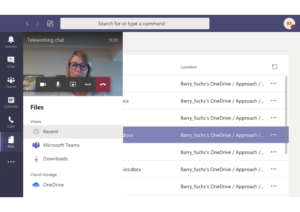
Like many of you, each of us at Approach has been working from home since March. What we thought might be a matter of weeks back has stretched into months – some are wondering if desk-based employees will ever return to offices. This week, Ask Approach looks at the changes and opportunities that teleworking has brought during the COVID-19 emergency.
Flexible L&I telehealth policies
In April, L&I announced two policies as a response to COVID-19, but with benefits for injured employees and employers throughout Washington state. These changes allow injured employees to:
- Have any or all of their medical appointments, including the first evaluation, via telehealth
- Have telehealth appointments from home, instead of driving to an “originating location,” such as a provider’s office
These policies were going to expire this month (July 2020), but have now been extended all the way through June 2021. They mean that, when appropriate, the injured employee can be seen by a provider remotely from the very first visit — and possibly all the way through their recovery.
“The expansion of the telehealth policies are a great advancement for Washington workers’ comp,” says Jamie Graham, VP of Claims for Approach, continuing “They allow injured employees to stay engaged with their treatment plans and recovery, while helping employers to get clearance to facilitate return-to-work in a light-duty or full-duty capacity.”
Telehealth success story
We’ve seen first-hand how these new telehealth policies can help the employee and employer. One of our transportation clients had a worker who was injured in January of this year. The employee was restricted from any worker at first, which meant that the employer had to pay Kept-on-Salary to avoid time-loss on the claim.
“Expanded telehealth policies are helping everyone to adapt…and get injured employees back to light-duty as soon as possible”
This situation could have gone on for many months because of COVID-19; however, thanks to the expanded L&I telehealth policies, the injured employee was able to be seen remotely in April and released to a light-duty position.
Last month, the worker had a follow-up visit by telehealth and — great news! — was found to have regained range of motion all the way back to his pre-injury baseline. As of last week, he has been released to work full time and full duty.
“This is a great example of how the expanded telehealth policies are helping everyone to adapt right now,” says Jamie Graham. “L&I has not relaxed its time-loss policies at all during the COVID-19 pandemic, so it’s as important as ever to get injured employees back to light-duty as soon as possible.”
Client service while teleworking
“We all have to connect.” says Liz Evans, director of business development for Approach. “Whether you’re in sales or service, you still need to connect and find ways to redefine the value you can provide for clients right now.”
Liz has been working with current and potential clients throughout the pandemic and has found that this new way of working has positives as well. “Right now is an opportunity to learn how your clients and colleagues like to communicate,” she says. “Not everything has to be a video call; some people prefer a regular phone call or just email.”

And, even though office visits are rare at this point, “I’ve had the opportunity to talk by video with people in Minnesota or New York, which is something that wouldn’t have happened before. Their companies have workers in Washington state, and I’m able to educate them about Retro and workers’ comp here with a virtual face-to-face meeting.”
Staying safe and comfortable
Finally, as days have slowly turned into weeks and months away from the office, that casual home office you set up in March might be feeling cramped or uncomfortable at this point. In an informal survey last month, about half of our clients said that new aches and pains were a concern since working-from-home began.
That’s why we held a Ergonomics of Working from Home webinar last month – filled with easy, low-cost tips for improving the quality of your homeworking space and furniture. If poor ergonomics lead to a medical complaint, this could be accepted as a workers’ comp claim. So, it’s important to make sure that you and your co-workers aren’t experiencing discomfort or pain as a result of a home-working setup.
Staying informed
One thing we know is that COVID-19 is going to impact our workplaces, safety programs, and claims for months and years to come. You can find all of our COVID-19 articles and guidance at https://approachms.com/employer-resources-for-covid-19-coronavirus/. Or contact your Retro Coordinator with any questions on how to manage changes in workplace claims and safety during this time.
